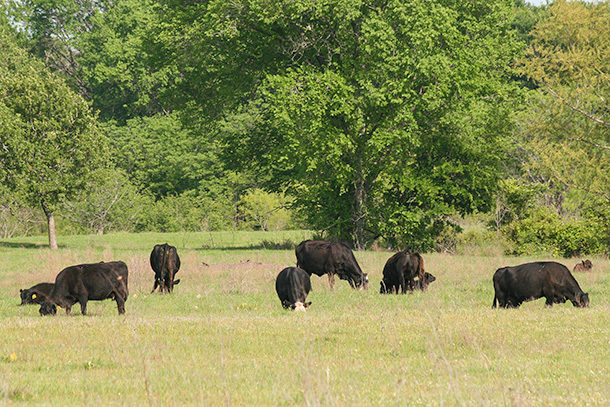We make management decisions in an effort to increase pasture forage yield, but a cow does not harvest every pound of grass grown in our pastures. A cow grazing the same pasture 365 days a year will only consume one-fourth of the forage grown. Cattle foul (pee and poop on), trample and refuse to use portions of pastures in this “continuous” grazing system. The larger the area they have at one time, the more selective they will be about which parts of the pasture they want to use and which ones they ignore.
Allow me to share an example from Missouri. A tall fescue pasture that is not fertilized with nitrogen in the spring will produce 3,000 pounds of forage, and one that is fertilized with 60 pounds of nitrogen will produce 5,000 pounds of forage – a 66% increase. Increasing forage utilization from 25% to 40% will increase the amount of forage consumed per acre by nearly the same amount. Let’s compare fertilizer versus increasing forage utilization without fertilizer. Twenty-five percent of 5,000 pounds is 1,250 pounds, and 40% of 3,000 pounds is 1,200 pounds. With today’s fertilizer prices, does it make more sense to maximize yield to or to try and improve the utilization of forage already grown?
Perhaps you are in an area where pasture fertilization is a foreign concept. Being from New Mexico, I never dreamed of worrying about N, P and K levels on pastures I graze cattle on. Another way of thinking about this in a non-fertilizer area is how many more grazing days can my pastures produce? In arid environments, like New Mexico where cows graze year round, that might mean an increase in carrying capacity. Other places where hay is commonly fed in the winter, you will see a reduction in the number of days hay is fed in the winter. I have done the math in Missouri, and in general, the cost per cow per day when feeding hay is 50% greater than when grazing, assuming the nutrient composition of the grazed forage and stockpiled pasture forage is the same.
What will it take to increase forage utilization from 25% to 40%? According to data presented at the University of Missouri Extension Grazing Schools, having a six-paddock rotation system will increase forage utilization to 40%. One caveat to consider is that pastures in Missouri are much smaller than other locations. In areas where pastures are measured in sections, think about the shape of the perimeter fence and water access points. Increasing stock density (pound of cow per acre) in a five- or six-section pasture with only one water access point and a non-square perimeter fence is not likely to help forage utilization. Getting cattle much further than a mile from water can be challenging, especially if the cattle are non-native to your area.
In continuous grazing, cattle graze areas near water and shade more frequently. These plants get minimal recovery time. Water placement may be in a corner of the pasture and not easy to change. When that occurs, perhaps consider using mineral supplements or shade to lure cattle to underutilized portions of the pasture, if breaking the pasture down into smaller paddocks is not possible.
I hear often from producers reluctant to implement grazing systems because they feel it is too expensive or too much work. An effectively managed grazing system does not have to mean all or nothing nor daily moves from paddock to paddock or installing a dizzying amount of temporary electric fence. The reality is that we have options on ranch already. If your ranch has four to six pastures, yet you have cattle in each pasture continuously, consider grouping the cattle into one larger bunch and rotating them through the pastures. In doing so, you are giving plants the opportunity to rest and recover between grazing bouts. In my experience, the infrastructure that is often lacking is water access. Being able to water large numbers of cattle, especially in the heat of the summer months, is critical.
Recovery is a very important concept to grass growth. The leaves of a plant are the solar panels the plant uses to acquire energy from the sun. Anytime we remove all the solar panels, the plant has to use root energy reserves to grow new leaf material. When this occurs repeatedly within a grazing season, root systems shrink and the plant becomes less productive. Check out this YouTube video from the University of Kentucky Extension. It shows forage growth over a five-day period after grazing all leaf material off versus leaving stubble behind. Not surprisingly, the plants that had all leaf material grazed off grew back at a slower rate.
The length of recovery period needed is dependent on the type of forage you are grazing and the season it is being grazed. For tall fescue, the recovery period needed in the spring is much less than during the fall. I generally shoot for a minimum of three weeks recovery in the spring and double that during summer and fall. Those numbers are generalizations. Try to make friends with a good grazer in your area that pays attention to recovery time. It would not be surprising to hear of recovery times that are greater than six months in arid environments. What your ranch needs is dependent on weather, soil, management, slope and a whole host of other factors.
This year is setting up to be a real challenge in the beef industry. As you make management decisions this spring, think about how you can graze more and feed less. Implementing a grazing system on your operation is a great place to start. ![]()
PHOTO: Grouping cattle and rotating them through pastures gives plants an opportunity to rest and recover. Staff photo.
-
Eric Bailey
- Assistant Professor
- State Beef Extension Specialist
- University of Missouri
- Email Eric Bailey









